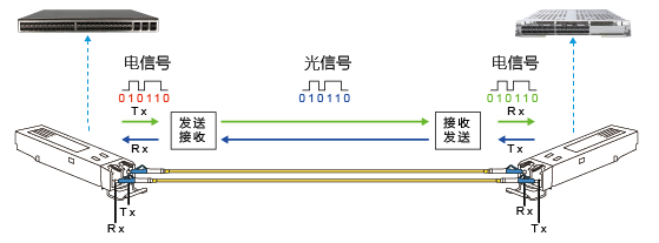
Optical modules are crucial components in fiber optic communication systems, responsible for performing optoelectronic conversions during the transmission of optical signals.
Operating at the physical layer of the OSI model, optical modules play a vital role in fiber optic communication systems. They primarily consist of optoelectronic devices (such as optical transmitters and receivers), functional circuits, and optical interfaces. The main functionality of an optical module is to achieve optical-to-electrical (O/E) and electrical-to-optical (E/O) conversions. The working principle of an optical module is illustrated in the diagram below.
At the transmitting interface, an electrical signal with a specific bit rate is inputted. After undergoing internal processing by the driver chip, the corresponding modulated optical signal is emitted by the driver's semiconductor laser diode (LD) or light-emitting diode (LED) at the appropriate speed. The emitted optical signal is then transmitted through the optical fiber. At the receiving interface, the optical signal is converted back into an electrical signal by the optical detector diode (photodiode) and amplified by a preamplifier before being output as an electrical signal with the corresponding bit rate.
At FSYTech, we adopt innovative thinking and uphold the highest quality standards. We provide one-stop solutions for optical module design, manufacturing, and sales. Our product range includes a comprehensive series of compatible optical modules, such as 800G, 400G, 200G, 100G, 10G, and 155M, along with AOC (Active Optical Cables) and DAC (Direct Attach Cables) products.
(Note: The translation provided here assumes "FIBERTOPSFP" refers to a company name, FSYTech. Please adjust accordingly if it refers to a different entity.)
